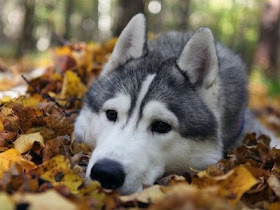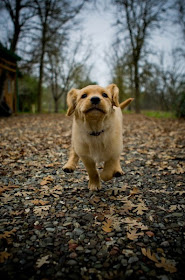Hoy estrenamos nueva estación, Otoño: la caída de las hojas, la bajada de las temperaturas, la llegada de la lluvia... Apetece el cambio!!
En esta época del año el cambio mas importante para nuestros perros es que van a mudar el pelo preparándose para las bajadas de las temperaturas y el frío del invierno. Esta muda se debe a la bajada de temperaturas y a la disminución de horas de luz al día (fotoperiodo). Se cambia el pelo más fino y ligero del verano por uno fuerte y tupido para el invierno. Es frecuente, especialmente en perro urbanos, que la muda del pelo se mantenga a lo largo del año. En estos casos también existen los picos mencionados de primavera y verano, pero hay una pérdida constante de pelo. Esto no sucede en animales que viven a la intemperie, y es debido a que los perros que viven en casa no padecen grandes cambios de temperatura (aire acondicionado en verano y calefacción en invierno)
Para afrontar mejor los cambios del otoño aqui os dejo unos consejos:
1. Un baño sirve para agilizar la pérdida de pelo muerto y permite eliminar los enredones del pelo con facilidad.
2. Hay que cepillar mucho el pelo. Durante la muda, el cepillado debe ser diario y en algunas razas, por ejemplo las nórdicas o San Bernardo, varias veces al día.
3. Utiliza el tipo de carda, cepillo, peine o manopla adecuado al pelaje del perro. Con pelajes cortos y duros (por ejemplo labrador, boxer, bull terrier, pit bull…) son aconsejables las manoplas de goma. En perros con pelo medio y subpelo (pastor alemán, golden retriever, husky…) lo idóneo es la carda o el cepillo. Y en razas con pelo largo (por ejemplo bichón, scottish o westy, que apenas pierden pelo) siempre hay que emplear primero un peine para eliminar los enredones y facilitar el posterior cepillado con rastrillo. En todos los casos las puntas no deben ser agresivas las púas acabadas en forma de cerilla son menos traumáticas para la piel.
4. No hace falta utilizar suplementos para mejorar el pelo o para la caída en perros bien alimentados. Un buen pienso rico en proteínas es lo esencial, especialmente de cara al invierno, para fortalecer su sistema inmunitario.
5. Si alguien de la casa es alérgico hay que cepillar al perro siempre en el exterior. La caspa que se desprende con la muda de pelo de los perros es un alérgeno de primer orden. Siempre cepillaremos a nuestros perros en el exterior (terraza, jardín, parque…). Los pelos que recojamos debemos tirarlos a la basura.
6. Es un buen momento para hacerle un corte de pelo, la sensación de caída de pelo será menor.
7. Es una época en la que podemos disfrutar todavía de buenas temperaturas. Hay que aprovechar para dar largos paseos antes de que llegue el frio del invierno.
8. El otoño puede ser una época de muchas lluvias. Aprovechar para comprar un chubasquero que evitará que se moje el cuerpo. Hay que secar muy bien el manto del pelo para evitar problemas en la piel y en las vías respiratorias.
Today we release season, Autumn: the fall of the leaves, the descent of temperatures, the arrival of the rain... Fancy a change!!
At this time of the year the most important change for our dogs is that they are going to change the hair being prepared for the descents of the temperatures and the cold winter. This hair shedding owes to the descent of temperatures and to the decrease of hours of daylight (photoperiod). They changes the thinnest and light summer hair for the strong and thick one for the winter. It is common, especially in urban dogs, that hair shedding is kept throughout the year. In these cases there are also peaks mentioned on spring and summer, but also there is a continued loss of hair. This does not occur in animals living in the open, and it's because the dogs living at home does not suffer from large temperature changes (air conditioning in summer and heating in winter).
I leave some tips to confront better the autumns changes:
1. A bath serves to improve the loss of dead hair and allows to remove hair tangles easily.
2. It is necessary to brush very much the hair. During the shed, the brushed is necessary to be a daily and in some breeds, the nordic ones, St Bernard for example, several times a day.
3. Use the type of card, brush, comb or mitt suitable to dog fur. With short, hard coats ( labrador, boxer, bull terrier, pit bull ...) are advisable rubber mittens. In dogs with medium hair and undercoat (German shepherd, golden retriever, husky ...) the suitable thing is the carding or the brush. And in breeds with long hair (for example Maltese bichon, scottish or westy, that scarcely lose hair) it is always necessary to use first a comb to eliminate the hair tangles and to facilitate the later one brushing with rake. In all the cases the tops must not be aggressive, the prongs ended in match shape are less traumatic for the skin.
4. It is not necessary to use supplements to improve the hair or for the fall in well-fed dogs. A good feed rich in proteins is the essential thing, especially for winter, to strengthen his immune system.
5. If someone of the house is allergic it is necessary to brush the dog always on the outside. The dandruff that emerges detached with hair shedding of the dog is an allergen of first order. Always brush our dog outside (terrace, garden, park …). The hair that we collect must be throw at the garbage.
6. It's a good time for a haircut, the hair falling sensation will be minor.
7. It is a time where we can still enjoy good temperatures. We must seize for long walks before the cold winter arrives.
8. Autumn can be a time of much rain. It´s useful to buy a raincoat that will prevent from wetting the dog´s body. It is necessary to dry very well the coat to prevent skin problems and respiratory tract.
 |
 |
Fotos 2 y 3: maddieonthings
Foto 4 The daily what
Fotos 5-9 vía theanimalblog
Fotos 1 y resto vía Pinterest
































Unos consejos muy buenos ;-) ¡¡¡
ResponderEliminarMuy buenos tips!! El pelo de los perros uffff con lo alérgica q soy!! jajajaja
ResponderEliminarUn beso!! V.
http://www.infrontrowstyle.com/